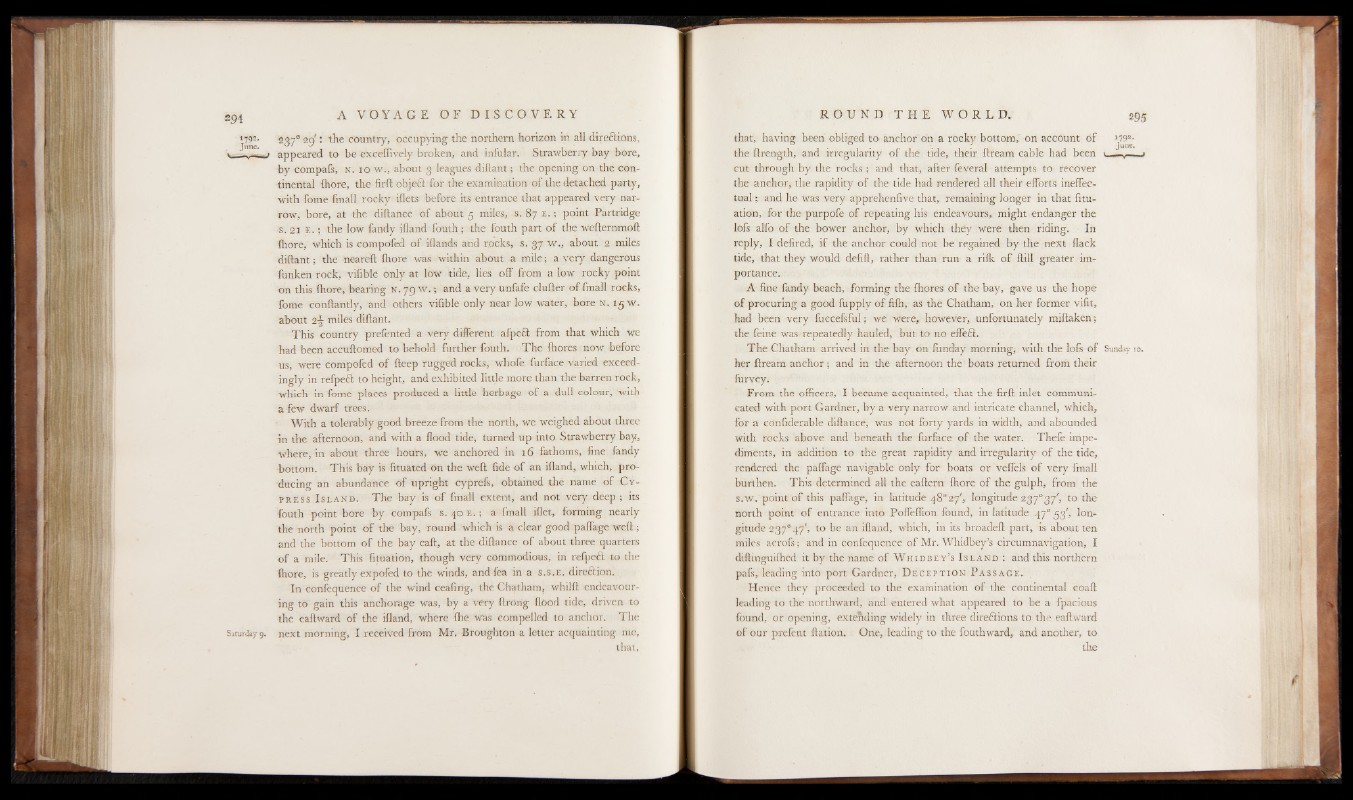
Saturday g.
2370 29': the country, occupying the northern horizon in all directions,
appeared to be exceffively broken, and infular. Strawberry bay bore,
by compafs, N. 10 w., about 3 leagues diftant; the opening on the continental
Ihore, the firft objeft for the examination of the detached party,
with fome fmall rocky iflets before its entrance that appeared very narrow,
bore, at the diftanee o f about 5 miles, s. 87 E .; point Partridge
s. 21 e . ; the low fandy ifland fouth; the fouth part of the wefternmoft
Ihore, which is compofed of iflands and rocks, s. 37 w., about 2 miles
diftant; the neareft Ihore was within about a mile; a very dangerous
funken rock, vifible only at low tide, lies off from a low rocky point
on this Ihore, bearing N. 79 w . ; and a very unfafe duller of fmall rocks,
fome conftantly, and others vifible only near low water, bore N, tgw .
about miles diftant.
This country prelented a very different afpeS from that which we
had been acculiomed to behold further fouth. The Ihores now before
us, were compofed of fteep rugged rocks, whofe furface varied exceedingly
in refpeft to height, and exhibited little more than the barren rock,
which in fome places produced a little herbage of a dull colour, with
a few dwarf trees.
With a tolerably good breeze from the north, we weighed about three
in the afternoon, and with a flood tide, turned up into Strawberry bay,
where, in about three hours, we anchored in 16 fathoms, fine fandy
bottom. This bay is fituated on the weft fide of an iftand, which, producing
an abundance o f upright cyprefs, obtained the name of C y p
r e s s I s l a n d . The bay is of fmall extent, and not very deep ; its
fouth point bore by compafs s. 40 E .; a fmall iflet, forming nearly
the north point o f the bay, round which is a clear good paffage weft ;
and the bottom of the bay eaft, at the diftanee of about three quarters
o f a mile. This fituation, though very commodious, in refpeft to the
Ihore, is greatly expofed to the winds, and fea in a s . s . e . direction.
In confequence of the wind ceafirig, the Chatham, whilft endeavouring
to gain this anchorage was, by a very ftrOng Il6od tide, driven to
the eaftward of the ifland, where Ihe Was compelled to anchor. The
next morning, I received from Mr. Broughton a letter acquainting me,
that,
that, havinar been obliged to anchor on a rocky bottom, on account ó f ' 792-
0 0 . ! June,
the ftrength, and irregularity of the tide, their ftream cable had been » - - ■
cut through by the rocks ; and that, after feyeral attempts to recover
the anchor, the rapidity o f the tide had rendered all their efforts ineffectual
; and he was very apprehenfive that, remaining longer in that fituation,
for the purpofe of repeating his endeavours, might endanger the
lofs alfo of the bower anchor, by which they were then riding. In
reply, I defired, if the anchor could not be regained by the next flack
tide, that they would defift, rather than run a rilk o f ftill greater importance.
A fine fandy beach, forming the Ihores o f the bay, gave us the hope
of procuring a good fupply o f filh, as the Chatham, on her former vifit,
had been very fuccefsful; we were, however, unfortunately miftaken;
the feine was repeatedly hauled, but to no effect.
The Chatham arrived in the bay on lunday morning, with the lofs of Sunday 10.
her ftream anchor; and in the afternoon the boats returned from their
furvey.
From the officers, I became acquainted, that the firft inlet communicated
with port Gardner, by a very narrow and intricate channel, which,
for a eonfiderable diftanee, was not forty yards in width, and abounded
with rocks above and beneath the furface of the water. Thefe impediments,
in addition to the great rapidity and irregularity o f the tide,
rendered the paffage navigable only for boats or veffels o f very fmall
burthen. This determined all the eaftern Ihore of the gulph, from the
s.w. point o f this paffage, in latitude longitude 237°37', to the
north point of entrance into Poffeflion found, in latitude 47° 53', longitude
237° 47', to be an ifland, which, in its broadeft part, is about ten
miles acrofs; and in confequence of Mr. Whidbey’s circumnavigation, I
diftinguilhed it by the name of W h i d b e y ’s I s l a n d : and this northern
pafs, leading into port Gardner, D e c e p t i o n P a s s a g e .
Hence they proceeded to the examination of the continental coaft
leading to the northward, and entered what appeared to be a fpacious
found, or opening, extending widely in three direflions. to the eaftward
of our pxefent ftation. One, leading to the fouthward, and another, to
the